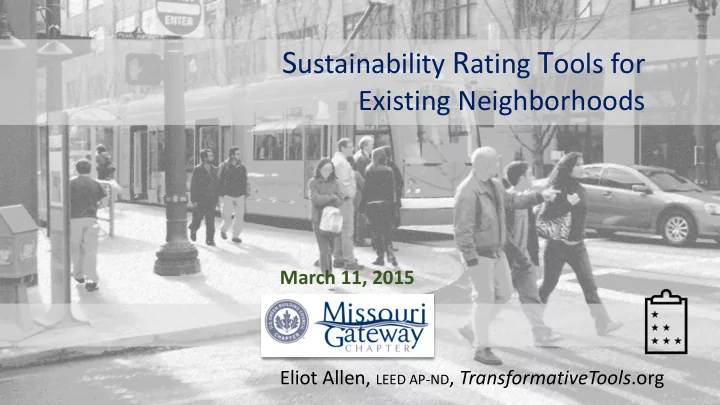

S ustainability R ating T ools for Existing Neighborhoods March 11, 2015 Eliot Allen, LEED AP-ND , TransformativeTools .org
Sustainability Rating Tools for Existing Neighborhoods Rating tools overview 3 tools - Living Community Challenge - 2030 Districts - Community Wildlife Habitat Local rating tools Tool selection criteria Q & A
The World of Rating Tools
Tool Dimensions Topical scope & physical scale Primary users Rating procedure & criteria Tool maturity & market impact Costs User support Standards conformity Overall usefulness
Living Community Challenge Tool Family: All Neighborhoods Provider: International Living Future Institute Physical Scale: Neighborhoods Minimum Requirements: Greenfields not eligible Year Introduced: 2014 Onsite Verification: Yes Tool Training Yes Tool Credential: Yes
LCC Petals Place Water Energy Health & happiness Materials Transect Equity L1 Habitat preserve Beauty L2 Rural agriculture L3 Village or campus L4 General urban L5 Urban center L6 Urban core
LCC Approach All ‘imperatives’ are mandatory, no optional credits Two stages: master plan compliance, community certification Two cert levels: petals (min. 3), community (all 20 imperatives) Certification requires 12 months of actual performance data Fees by acreage & cert type: $7500 (master plan, petals cert), up to $35k (community, full cert)
LCC Imperatives Integrated agriculture Net positive water, energy, and waste Sharing programs – tools, cars, books Disaster preparedness Maximum single-family dwelling floor area – 4,575 sq ft Equity offsets to charity – ½ cent for every dollar of project cost Public art – installations per capita Project team – at least two with ‘ Just’ label
JustOrganizations.com
2030 Districts Tool Family: Existing Neighborhoods Provider: Architecture 2030 Physical Scale: Neighborhoods Minimum Requirements: Multiple existing and planned buildings Year Introduced: 2011 Onsite Verification: Yes – best in class Tool Training Yes Tool Credential: No
2030 District Goals New Construction Energy: 60% reduction, carbon neutral by 2030 Water & Transportation CO2e: 50% reduction Existing Buildings & Infrastructure Energy, Water & Transp CO2e: 10% reduction, 50% by 2030
2030 Districts Members Property owners Professional stakeholders – designers, contractors Community stakeholders – non-profits, govt agencies Benefits Shared assessment tools Common procurement Training/technical support In-kind professional services Packaged incentives, favorable financing
Community Wildlife Habitat Tool Family: Landscape & Parks Provider: National Wildlife Federation Physical Scale: Neighborhoods, cities, counties Minimum Requirements: Existing habitat Year Introduced: Unknown Onsite Verification: No Tool Training Yes Tool Credential: No
Community Wildlife Habitat Flexible scale: HOA, neighborhood boundary, municipality, county 2 to 5 years for certification Requirements: - public outreach - % of properties create habitat with: food, water, cover, nesting places, and implement sound gardening Annual recertification required
CWH Steps 1. Define project boundary. 2. Assemble team. 3. Register: $75. 4. Execute work program: % of properties with required habitat. 5. Submit for certification.
Local Rating Tools Community Indicators NYSDOT Greenlites Consortium dot.ny.gov/programs/greenlights communityindicators.net Regional Indicators Initiative regionalindicatorsmn.com National Neighborhood Indicators neighborhoodindicators.org Chicago Green Score greenscore.es Sustainable Neighborhood Network sustainableneighborhoodnetwork.org Louisville Green Living louisvilleky.gov/government/brightside/ greenliving
Tool Selection Criteria Type and scale of built environment New or existing Neighborhood or community Infrastructure network Decision-making context Technical procedure Public process Advisory, celebratory, or regulatory
Tool Selection Criteria Comprehensiveness Holistic rating: environmental, social, economic Single-purpose or subset Minimum elements Minimum quantities of land or buildings Prohibited elements, e.g. reclaimed land
Suitability for intended users Tool Technical expertise required selection Suitability for non-technical users in a participatory criteria setting Rating timeframe Preparation time, total overall time to obtain rating Costs Membership, registration, filing fees Certification review fees Preparation of required documentation Participation in review process
Tool Selection Criteria Rating procedure Rating by: self-assessment, tool provider (2 nd party), independent reviewer (3 rd party) Analog versus digital process Documentation burden On-site verification Periodic re-exam to maintain rating
Tool Selection Criteria Rating criteria Participants in formulation, transparency of process Scoring and weighting basis Mandatory versus optional Prescriptive versus performance Periodic updating to maintain technical currency Locally-adaptable
Tool Selection Criteria Provider history and user support Type of organization History with tools Dedicated staff & support services, e.g. training, credential Conformity with standards International Standards Organization (ISO) standards STAMP – Sustainability Assessment & Measurement Principles (IISD)
Tool Selection Criteria Tool maturity and market impact Years of operation Current generation of tool Number of ratings performed Overall usefulness Alignment of tool output with user objectives Value proposition Efficiency ratio: output benefits/input effort
Looking Ahead Rating tools with impact and endurance will: Be affordability and efficient Conform with standards Produce verified results
Questions?
Eliot Allen, LEED AP-ND eliot@transformativetools.org Twitter @TransformTools
Recommend
More recommend